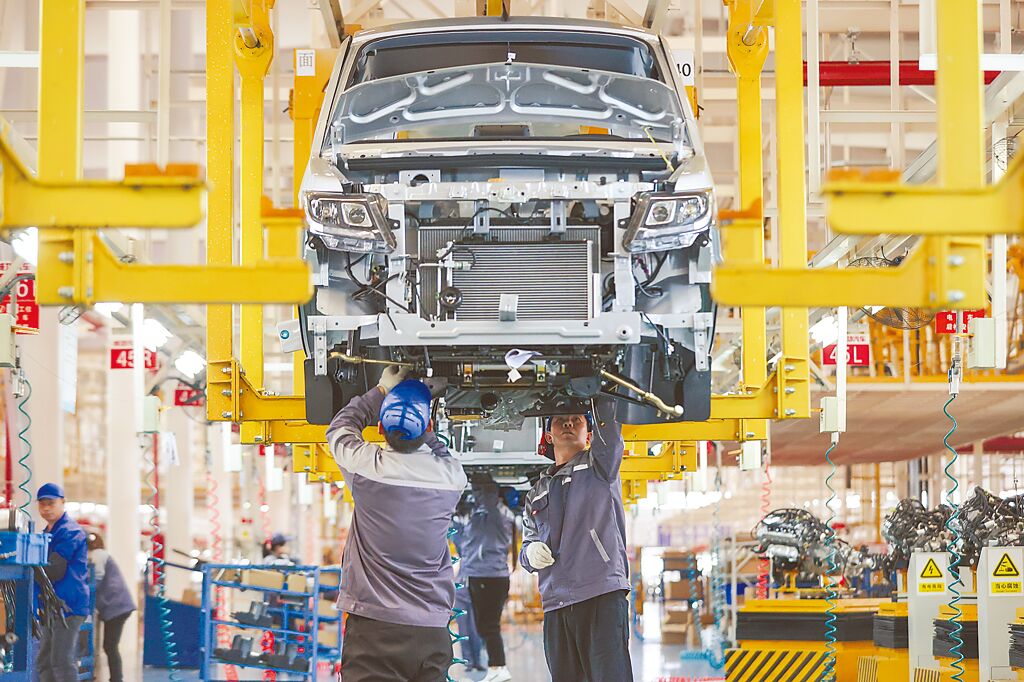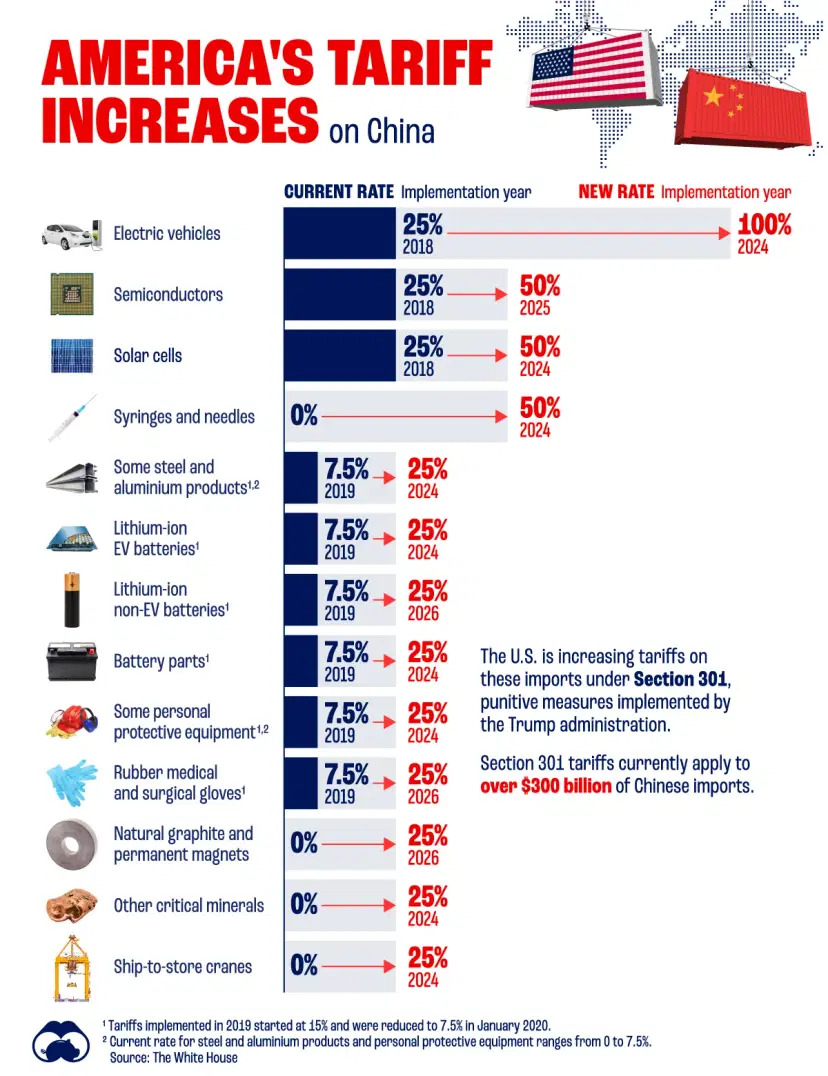
An electric vehicle factory in Zunyi City of Guizhou Province, China.
The White House announcement on May 14 of exceptionally high tariffs on Chinese electric vehicles, solar products, lithium cells and other products, has confused trade experts. The decision is backed by virtually no trade principles.
Following a four-year review under Section 301 of the U.S. Trade Act of 1974, tariffs on EVs imported from China will be increased from 27.5 percent to 102.5 percent, effective this year. Lithium batteries and parts for EVs will jump from 7.5 percent to 25 percent. In 2026 non-EV batteries will increase from 7.5 percent to 25 percent. Tariffs on solar cells imported from China will be raised from 25 percent to 50 percent this year, and tariffs on semiconductors imported from China will be raised from 25 percent to 50 percent, effective next year.
While the tariff increases also cover traditional products, including steel, aluminum, the main targets are high-tech and emerging technology products.
High tariffs on non-threats
Special tariff increases are normally based on sharp increases in imports that significantly erode the home market and threaten domestic business and workers. But there is no such a threat in this set of tariff increases.
According to official U.S. trade statistics, the total motor vehicle import volume in 2023 was $254.67 billion. Mexico, Canada and Japan together accounted for 50 percent of that. China was not even listed as a supplier. According to the U.S. Department of Commerce, China accounted for 1.1 percent of total U.S. EV imports in 2018, and the same share in 2023. During the first quarter of this year, total U.S. EV imports reached 109,373 units, with 951 units from China, or 0.9 percent — comfortably in the area of “nil” (under 3.0 percent). Total solar products imports to the U.S. in was $5.03 billion, with China accounting for only $30 million, or 0.6 percent. So how can anybody claim that this tiny market share constitutes a threat to American industry and workers?
The White House gave a reason for the increases: 70, 80 or 90 percent of China’s achievements have been made through compulsory technology transfers, or theft of intellectual property. But it hasn’t provided any evidence, any facts or any statistics to support this alarming claim.
According to data provided by the World Industrial Property Organization, or WIPO, during the seven-year 2016-22 period, total invention patents in green, low-carbon technology reached 558,000. China accounted for 178,000, or 31.9 percent of the total, comfortably exceeding that of the United States and European Union. Is there any need, therefore, for China to “compel” technology transfers or even steal IP? In 2023, the world turned out 14.35 million EVs. Among the leading manufacturing countries, China produced 9.5 million units, or two-thirds of the global total, three times the output of the U.S. (2.94 million), and six times that of the EU (1.47 million). If the U.S. and EU have the technology and patents, why couldn’t they have produced more?
Emerging tech decoupling?
What’s really behind the hefty tariff increases on Chinese products? The logical explanation can only be politics. President Joe Biden needs to show tough on China during a presidential election year. Since there is no convincing trade data, a national security narrative is inevitable. In particular, the hikes could please the labor sector in swing states, including Ohio, Pennsylvania and Michigan.
Raising tariffs serves not only electoral purposes but also Washington’s longer-term strategy to de-couple with China in high-tech and emerging technologies. The products subject to quadruple tariff increases include new-energy technologies, semiconductors information technology and key minerals. The U.S. market will be closed to Chinese electric vehicles, solar products, lithium batteries, semi-conductors no matter how well received such products are by the users. In the reverse direction, advanced semiconductors and manufacturing machines are barred from going to China.
All this will only lead to a new scenario: The U.S. and China will be decoupled de facto in those high-tech and emerging technology areas, and supply chains will be reshaped on the basis of America’s shared values with like-minded allies. This scenario, in turn, serves the White House’s national security strategy, which identifies China as America’s largest threat.
President Joe Biden and cabinet secretaries Tony Blinken, Janet Yellen and Gina Raimondo have repeatedly reaffirmed the policy of no decoupling with China. But the latest tariff move goes in exactly the opposite direction.

(Photo: Visual Capitalist)
New trade war a bad idea
The unilateral tariff increase by Washington clearly violates World Trade Organization rules. Concrete tariffs can only be set through negotiations under the WTO framework; there is no right by individual members to impose a new tariff unilaterally. Once a tariff is set, it must be applied to all WTO members without discrimination.
In 2018, when the Trump administration imposed sweeping unilateral tariffs on Chinese goods, China, while imposing counter-tariffs on U.S. products in retaliation, sued the U.S. via the WTO’s dispute settlement mechanism in September 2020. The WTO panel found the U.S. unilateral tariffs in violation of WTO rules and pronounced them illegal. This time, China will sue the U.S. again and will undoubtedly prevail.
Meanwhile, China retains all options for counterattack. It could deploy any number of options: much higher tariffs on selected U.S. products, or temporary restrictions on U.S. business in selected sectors.
That said, a new trade war is not the answer. The extremely high tariffs on selected Chinese new-energy technology products or materials will also result in losses for American businesses and consumers. For example, the EV market in the U.S. is not indispensable for China. As mentioned previously, China accounted for 31.9 percent of total world invention patents in green, low-carbon technologies, so Chinese EVs have found huge market demand in Asia, Europe and Latin America.
Tesla investment in China has been extremely successful, and Chinese investment in the U.S. will undoubtedly benefit American consumers. It will create a tremendous supply chain based in the U.S., with thousands of jobs, and accelerate the EV industry in America. A Bloomberg report estimates that, by the end of 2026, total world EV stock will hit 100 million, compared with just 40 million at the end of 2023.
At that rate, 20 million new EVs will have to be produced each year over the next three years. Total world EV output in 2023 was 14.35 million units, and China accounted for two-thirds of that. The need for another 20 million units annually offers plenty of room for EV manufacturers in China, the U.S., the EU and elsewhere.
The same report also estimated that by 2040, the total global EV stock will reach 700 million — with 40 million more units needed each year over the next 14 years (2027-40), doubling the annual demand worldwide in the 2024-26 period. In short, there is plenty room for EV production and popularization, both in the U.S. and the world over.
Washington needs to change its Cold-War mentality, remove the high tariffs and move back to the track of mutually beneficial cooperation with China. In this way, it can accelerate the development of new-energy technology in both countries, contribute to the global fight against climate change and help the people of the world at large.